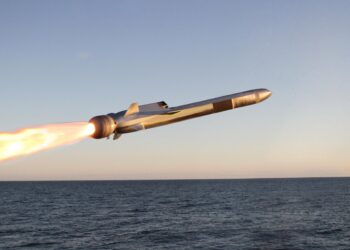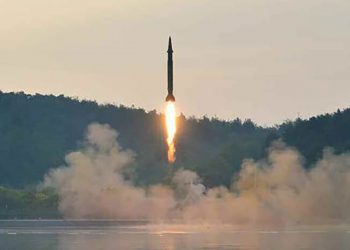Moscow: Russian Space Agency head Anatoly Perminov recently congratulated Yury Solomonov, general designer of the Moscow Heat Technology Institute, on the successful submarine launch of a new sea-based strategic missile, the Bulava, which was developed by his institute. The launch was part of a series of flight tests. Such publicity given to an event so ordinary and routine may seem strange, but only at first glance.
It was not on the spur of the moment that Russia's aerospace industry's top man congratulated the developers of the missile. The successful liftoff of the Bulava on June 27 not only broke the streak of bad luck that had dogged the missile, but has also offered hope for a revival of the sea component of the Russian nuclear triad.
Historically, the Soviet Union and later Russia have preferred to base their strategic nuclear forces on the ground, giving second place to strategic aviation and missile-carrying submarines.
In all probability, there were several reasons for this. To begin with, the ground forces have always outstripped the naval forces in development. Second, sad as it sounds, Soviet strategic bomber aviation was way behind that of the potential opponent.
And, most important of all, both sea- and air-based carriers, themselves highly technical machines, needed a high level of logistical support, which at all times in all of the armed forces has only been provided when funds were left over from other projects.
On the other hand, it is not true that the Soviet leadership paid too little attention to sea-launched missiles.
On the contrary. Within a short period of time, through super-human efforts and inconceivable costs, the Soviet Union was able to outnumber the United States in nuclear-powered missile-carrying submarines and their missiles. Admittedly, the reasons had more to do with politics and intimidation than military and technological advantages.
Here is an excerpt from the 1979 Agreed Statement to the Strategic Arms Limitation Treaty II (SALT-II):
“Modern submarine-launched ballistic missiles are: for the United States of America, missiles installed in all nuclear-powered submarines; for the Union of Soviet Socialist Republics, missiles of the type installed in nuclear-powered submarines made operational since 1965.”
The Americans decided not to count the first generation of Soviet sea-launched nuclear weapons, believing, with reason, that they posed no threat. But the Soviet leadership was perfectly aware of that, too.
So, beginning in April 1962, a real effort was mounted to improve this state of affairs by commissioning the development of a new missile, the R-27, from Vladimir Makeyev's design bureau. A companion project was launched to develop the new Navaga-class submarine.
The new missile was launched from a submarine as early as September 1967. The first twin launch followed within six days; and in December 1969, the world's first salvo of eight R-27 missiles was fired.
The Navaga-class nuclear-powered missile-carrying submarines became the largest series of Soviet submarines equipped with strategic weapons. In 1975, the Soviet Union outstripped the United States in the number of missile-carrying submarines and missiles. The following short table makes for impressive reading:
1960: U.S. – 3 submarines and 48 missiles (3-48);
Soviet Union – 0-0 (the first Soviet K-19 submarine
with three missiles became operational in November 1960);
1967: U.S. – 41-656; Soviet Union – 2-32;
1970: U.S. – 41-656; Soviet Union – 20-316;
1975: U.S. – 41-656; Soviet Union – 55-724;
1981: U.S. – 40-648; Soviet Union – 62-950.
A several-fold increase in strategic weapons makes no sense without corresponding improvements in cost and quality. Churning out submarines day and night, the shipyards were guided by one overarching principle: The plan must be fulfilled at all costs.
But no effort was made to establish a proper infrastructure, develop basing facilities or build up repair capacities. The training system, moreover, was beneath any criticism. The overall result, combined with bad workmanship, was that despite their numerical superiority fewer Soviet submarines were on patrol duty than American ones. Most of their time was spent in repair docks.
What is more, preparations for putting to sea were sometimes made with ridiculous negligence. The commander of one Navaga in the Northern Fleet, in order not to upset the patrol schedule, had to mount his own Ural motorcycle, hitch up a trolley and haul two torpedoes up to the ship from its allowance of ammunition capable of destroying half of Europe.
To be fair, the fleet's logistics headquarters had allocated an ambulance vehicle, of all things, for the purpose, but it never showed up.
The Soviet Union has never lived down its obsession with large-scale projects and big numbers in a drive to get ahead of the potential opponent. In response to the American Ohio-Trident sea-based weapons system, it developed the behemoth Akula (Typhoon)-class submarine, which displaced 33,000 metric tons and came equipped with 20 silos for the rather hefty, solid-fueled R-39 missile with a liftoff weight of 90 (metric) tons.
But the American boat, with a much lower displacement of 18,700 tons, could carry 24 Trident missiles and had a more quiet acoustic profile and, as a result, better survivability.
One hopes that in view of today's threats, which call for constant readiness and mobile forces, Russia will learn from the past when deploying its new naval strategic weapons.









